◆ State ROW Permits ◆
ATVs/UTVs ◆
Connection permits (driveways, roads and streets) ◆
Work on highway ROW permits ◆
Utility permits ◆
Utility accommodation policy ◆
Broadband deployment ◆
Utility coordination ◆
Utility permits on WisDOT railroad property ◆
State highway detour permits ◆
Environmental coordination ◆
Highway maintenance
Route definition |
Registration |
Ordinances |
Routes on state highways |
Merrimac Ferry |
Trails |
Route and trails crossings |
ATV route sign permitting |
Special signing |
Signing FAQs |
Contact |
Safety
Introduction
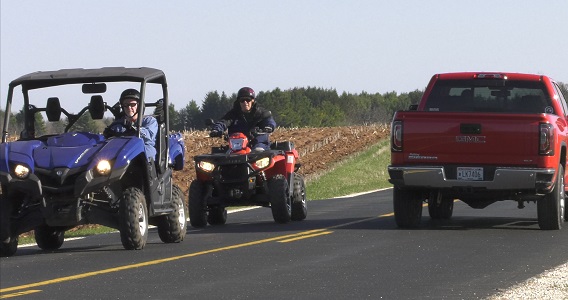
Photo courtesy of the Wisconsin ATV Association
Wis. Stat. s. 23.33 allows all-terrain vehicles (ATVs) and utility terrain vehicles (UTVs) to operate on a state highway in certain cases, which are detailed in sections A - C below. An ATV ordinance must be enacted by a municipality and/or county before operation may occur.
For the remainder of this webpage, ATVs and UTVs will be labeled collectively as ATVs. Since ATVs are not allowed to operate on interstate highways, none of the information on this webpage applies to interstates.
ATV registration
All ATV registrations are handled by the DNR – not WisDOT. Go to the DNR's
website for more information.
ATV ordinances
WisDOT does not have approval authority of local government ordinances, nor can WisDOT offer legal advice on how ordinances should be written. WisDOT only reviews ATV ordinances prior to processing traffic signing permit applications for ATV routes to verify that a town, village, city or county has referenced the appropriate sections(s) of s. 23.33 as detailed in sections A - C below.
The Wisconsin DNR does have sample ordinance language in Appendix A of its publication
ATV Route Guideline and Suggestions (A Community Official's Handbook). If necessary, consult your local government's corporation counsel or legal representative for advice.
ATV routes – definition
ATV routes by statute are on the roadway portion of a highway and not the shoulder or other parts of the right-of-way (ROW). A roadway is defined in Wis. Stat.
s. 340.01(54) as the, "portion of a highway between the regularly established curb lines or that portion which is improved, designed or ordinarily used for vehicular travel, excluding the berm or shoulder." On a 2-lane rural highway, the “roadway” is the area between the fog lines (white lines) as shown in picture (1). In an urban area, it is the area between the curbs in picture (2).
(1)
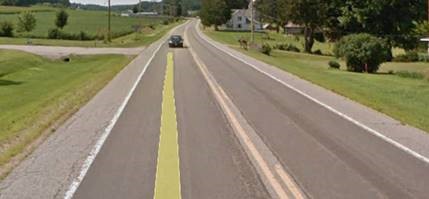
(2)
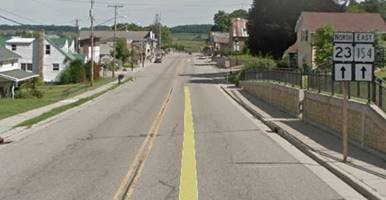
► It is important to understand that a roadway is not an ATV route until there is a signed ordinance and the roadway is signed/posted according to law.
ATV routes on state highways
The following information is divided into three sections based on current Wisconsin statutes.
A - ATV route designation on state highways
A town, village, city or county may enact an ordinance under Wis. Stat.
s. 23.33(8)(b)1. to designate a highway not under its jurisdiction as an ATV route. In this case, ATV operation on a
state highway or
connecting highway is allowed only if WisDOT approves the route. WisDOT's approval consists of an ATV route order that is issued for the designated segment of state or connecting highway. WisDOT will review an ATV ordinance to verify that the termini of the designated route is what WisDOT and the municipality or county agreed upon prior to issuing the route order.
B - ATV operation on state highways with speed limits of 35 mph or less within municipal boundaries
A town, village or city may enact an ordinance under Wis. Stat.
s. 23.33(11)(am)4. to authorize the operation of ATVs on a highway that has a speed limit of 35 mph or less and is located within the territorial boundaries of the town, village or city regardless of who has jurisdiction over the highway. In this case, ATV operation on a state highway is not subject to WisDOT approval. WisDOT will review an ATV ordinance to verify that the statute language “authorize the operation” has been correctly used instead of “designated."
Much of the state highway system operates with speed limits above 35 mph, and these higher speed highways remain off-limits to ATV use without approval from WisDOT. Speed limits on any highway are set after careful consideration to enhance safety and facilitate traffic flow for the traveling public and are typically not based on a specific type of vehicle. Anyone interested in how speed limits are established is encouraged to view WisDOT’s
pamphlet on the topic.
C - ATV operation on state highway bridges 1,000 feet or less in length
Under Wis. Stat.
ss. 23.33(4)(d)3.b. and
11(am)3., ATVs may be authorized to operate on the roadway or shoulder of a highway to cross a bridge 1,000 feet or less in length that is located within the territorial boundaries of a county, city, village or town, regardless of who has jurisdiction over the highway, and only if a county
and a city, village or town
both enact ordinances that apply to the bridge. In this case, ATV operation on a state highway bridge is not subject to WisDOT approval.
Under the law, ATVs must exit the highway as quickly and safely as practicable after crossing the bridge. WisDOT defines this as the first available road designated as an ATV route on either side of the bridge that is not a dead end, or an ATV trail on WisDOT ROW that is established after crossing the bridge in which ATVs may use. A bridge is defined as a structure (bridge, box culvert, etc.) more than 20 feet in length over a navigable waterway, highway or railroad. See Wis. Adm. Rule
Trans 212.02(2) and
pages from WisDOT's Structure Inspection Manual.
WisDOT reviews both municipal and county ATV ordinances developed under the two bridge statutes to verify that:
- The ATV route has the appropriate termini on each side of the bridge (the first available road or ATV trail as described above) and that both ordinances mention the same roads or trails.
- All five items listed in s. 23.33(11)(am)3.(a)-(e) are also included, which is required by the statute.
- The statute language "authorize the operation" has been correctly used instead of "designated."
The term "jurisdiction" in sections A - C above refers to maintenance jurisdiction instead of the ROW (fee title) owner or highway easement owner.
ATVs using the Merrimac Ferry
WisDOT policy is to only approve small segments of the state highway system as ATV routes to assist with local ATV route continuity and when it does not adversely affect the safety, operability, mobility and maintenance of the highway. Currently, there are no continuous local ATV routes in the Town of West Point in Columbia County or the Village/Town of Merrimac in Sauk County that warrant approving state highways 113 and/or 188 in Columbia County, including the ferry, as an ATV route. Therefore, ATVs are not allowed to use the ferry.
ATV trails on state highway ROW
WisDOT may permit an ATV trail within state highway ROW if sufficient space is available and it would not adversely affect the safety, maintenance and operation of the highway. A
DT1504 permit is required and a municipality, county or other governmental agency must be the applicant. Permit requirements are listed in
HMM 09-10-11, section 6.3. Go to the
state highway connection permits webpage for more information on the permitting process.
ATV route or trail crossings of state highways
Generally, ATV operators should look for existing driveways, local roads and permitted trail crossings when crossing state highways. This offers the safest path, and it is always the best practice for operators to plan ahead and know locations of legal crossings along their route. Below you will learn more about what to look for and also where there may be some exceptions.
The law and roadway crossings
Wis. Stat. s. 23.33 establishes many requirements for ATV operators including how to cross any type of roadway. At any location where crossing the roadway with an ATV is legal, and no obstructions such as curbs, a raised median, or fence prevent a safe and quick crossing,
s. 23.33(4)(d)1., requires the operator to:
- Stop completely prior to crossing,
- Yield to all pedestrians and vehicles of any type using the roadway, and
- Cross in the most direct manner possible.
While the law covers operator
behavior, it does not establish the rules about
where roadways may be crossed. Those issues are dealt within the highway-related statutes of Wisconsin law. In general, the authority charged with maintaining the highway controls where drivers and people can enter and exit the roadway, including to cross. For town roads, village/city streets, and county highways, the town, municipality, or county will control access to the roadway. State highways are regulated and controlled by WisDOT, which is charged with establishing and maintaining the state highway system.
WisDOT sometimes owns the rights to enter the highway from lands, and often controls access to state highways under Wis. Stat. ss. 84.09, 84.25 and 84.295. It is illegal to enter and cross one of those highways except at an authorized location.
Identifying a safe crossing
Most ATV operators may not know what access restrictions are on state highways. So WisDOT and DNR have developed some basic guidelines to help ATV operators legally cross state highways in the safest manner possible.
-
Look for existing driveways, local roads, and permitted trail crossings. These locations have been authorized by WisDOT. Driveways and road/street/trail connections are reviewed by WisDOT staff for engineering standards such as spacing and proper sight distance. It is better for ATVs to cross at these authorized locations versus other locations, especially on 55 mph highways with high traffic volumes. Motorists expect vehicles to enter and exit the roadway at these known access points. ATVs (and snowmobiles) crossing at unauthorized locations have a higher likelihood of being involved in a serious or fatal crash.
-
Crossing at non-driveway or road locations. WisDOT understands that ATVs operated by farmers, surveyors, utilities, etc., will need to cross a state highway at a location other than a driveway or road to get from one field to another or from one side of the highway to the other. As long as there is low-volume traffic, sufficient sight distance, and no damage done to the ROW, WisDOT will not take steps to prevent these crossings. When safety and highway maintenance are compromised, then WisDOT will take action to block ATV access and seek law enforcement assistance if needed.
Operators' role in protecting public assets
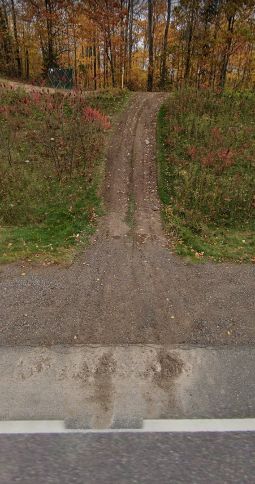
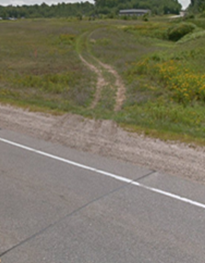 In addition to reducing the risk of a crash, another important reason for ATV operators to cross state highways at existing driveways, local roads, and permitted trail crossings is to minimize highway ROW damage. When ATVs destroy vegetation or cause rutting, it may lead to embankment erosion and clogged ditches. If ATVs deposit loose gravel and dirt onto the highway surface, it may lead to safety issues, especially for motorcycles.
In addition to reducing the risk of a crash, another important reason for ATV operators to cross state highways at existing driveways, local roads, and permitted trail crossings is to minimize highway ROW damage. When ATVs destroy vegetation or cause rutting, it may lead to embankment erosion and clogged ditches. If ATVs deposit loose gravel and dirt onto the highway surface, it may lead to safety issues, especially for motorcycles.
At the right are pictures of illegal crossings and the resulting damages. If the operator(s) that caused these damages cannot be found, then taxpayer dollars must be used for repairs, which reduces funding that could be used to perform regular highway maintenance. If the responsible operator(s) can be identified, then they may be liable for up to three times the cost to repair the damage under Wis. Stat.
s. 86.02.
For everyone's safety and well-being, WisDOT recommends that ATVs cross state highways at existing driveways and road/street intersections.
Are permits needed for ATV crossings?
WisDOT permits
are not required in the following situations because vehicular crossings already exist:
- At town, village, city or county road crossings. For example, ATV routes and trails crossing state highways.
- From a driveway on one side to a local road on the other side (or vice-versa).
- From a driveway on one side to a driveway on the other side.
WisDOT permits
are required in the following situations:
- Where no current vehicular crossing currently exists. For example, a new trail crossing from public/private property to public/private property.
- At a T-intersection where a new trail on public/private property would cross a state highway to a local road.
- Fixing or making improvements to an existing trail connection.
- Any time excavation, work, or improvement installation occurs in the ROW
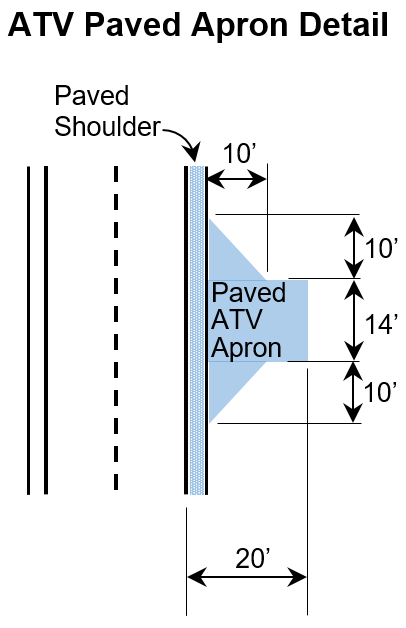
WisDOT will require installation of a paved apron where an ATV trail connects to the roadway of a state highway. An apron is needed to prevent maintenance issues such as gravel or mud deposits on the roadway surface and to reduce the risk of damage to wing blades when plowing snow. WisDOT may waive or temporarily suspend this requirement if appropriate.
A detail drawing will be required as part of the permit. An example is provided showing typical apron dimensions. These dimensions may vary depending on topography, geology, and other local conditions. Consult with WisDOT for apron requirements in areas that have curb and gutter.
ATV route sign permitting
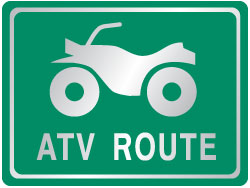 ATV route signs are required on state highways in order for ATVs to legally operate on them. A traffic signing permit is also required from WisDOT. The application
form may be filled out by a local government elected official or employee, or a county highway department may fill it out for the local government.
Send the completed permit application to the transportation region office along with a copy of the approved ATV ordinance(s).
ATV route signs are required on state highways in order for ATVs to legally operate on them. A traffic signing permit is also required from WisDOT. The application
form may be filled out by a local government elected official or employee, or a county highway department may fill it out for the local government.
Send the completed permit application to the transportation region office along with a copy of the approved ATV ordinance(s).
The permit application must include a map or sketch showing the general location of the signs. Once approved, the permittee orders the signs and related materials. County highway departments typically install signs on state highways since they have expertise with the
Wisconsin Manual of Uniform Traffic Control Devices (WMUTCD) and install many WisDOT signs. A municipality may install the signs or hire a licensed contractor with WMUTCD expertise upon prior WisDOT approval. All signs erected must comply with the WMUTCD.
Special ATV route signing
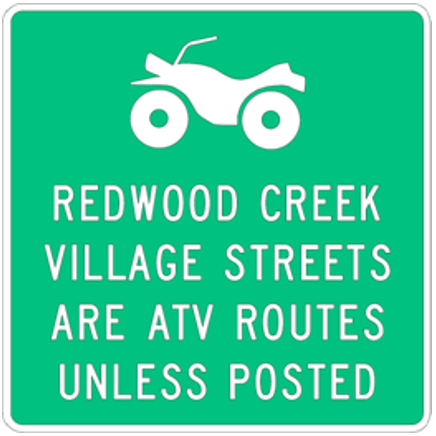 Under Wis. Stat.
s. 23.33(8)(e)3., a town, village, city or county may erect a sign on any highway that crosses its territorial boundary to alert motorists that all highways under its jurisdiction have been designated as ATV routes. On state highways, WisDOT approval is not needed, but a traffic signing permit is still required. The D11-10A sign — similar to the one shown on the left — may be used. The sign size on state highways is 36" x 36." WisDOT will review a town, village, city or county ATV ordinance to verify that it has designated all of its roads as ATV routes prior to granting permit approval to erect the sign on a state highway.
Under Wis. Stat.
s. 23.33(8)(e)3., a town, village, city or county may erect a sign on any highway that crosses its territorial boundary to alert motorists that all highways under its jurisdiction have been designated as ATV routes. On state highways, WisDOT approval is not needed, but a traffic signing permit is still required. The D11-10A sign — similar to the one shown on the left — may be used. The sign size on state highways is 36" x 36." WisDOT will review a town, village, city or county ATV ordinance to verify that it has designated all of its roads as ATV routes prior to granting permit approval to erect the sign on a state highway.
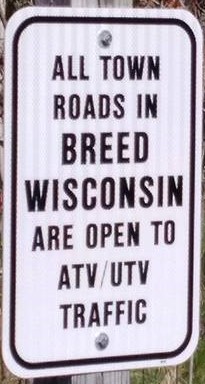 Smaller sign sizes may be used on local highways. A white sign with black letters (regulatory sign) may also be used as shown on the right. Consult the person in charge of road maintenance or a county highway department for more information on local road signing.
Smaller sign sizes may be used on local highways. A white sign with black letters (regulatory sign) may also be used as shown on the right. Consult the person in charge of road maintenance or a county highway department for more information on local road signing.
It is important to understand that these signs only apply to town, village, city or county roads
under its jurisdiction — not all roads within a municipality or county. For example, a sign with the message, “ALL ADAMS COUNTY ROADS ARE ATV ROUTES EXCEPT AS POSTED," only applies to county-maintained roads — not all town, village or city roads located within Adams County. ATV routes within those jurisdictions would require separate signing at their boundaries.
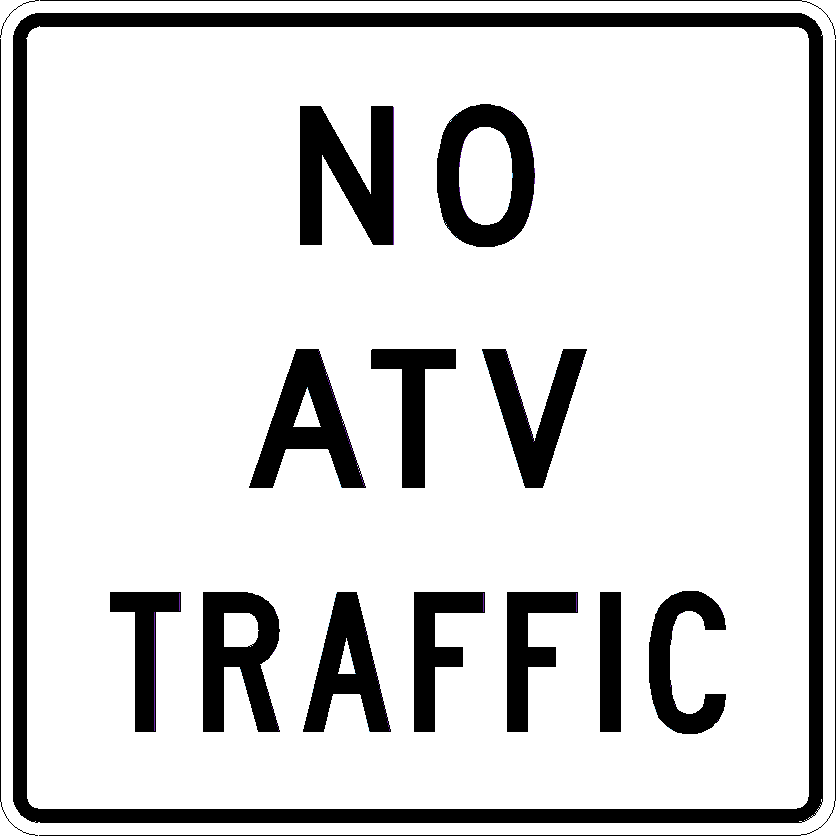
If the D11-10A sign is used, a "NO ATV TRAFFIC" sign (R5-51) may be displayed on any highway where ATVs are prohibited. Since it is a regulatory function, a white sign with black letters must be used. An example is shown on the right. The size on state highways is 24" x 24."
Note: The R9-16 sign shown on the left was recently approved for use in the Federal MUTCD on 12/19/23. WisDOT is reviewing the updated MUTCD to determine which revisions will also be implemented into WisDOT's MUTCD. At this time, however, the sign cannot be used on Wisconsin highways.
ATV route signing - Frequently asked questions
WisDOT has received many questions regarding ATV route signing both on state and local highways. To guide local units of government and ATV clubs on appropriate ATV route signing, this “frequently asked questions” webpage has been established. As more questions are asked of WisDOT, the questions and answers will be posted.
-
Do local units of government have to follow the WMUTCD for ATV route signing?
- Yes, the WMUTCD must be followed on all state and local highways. Per Wis. Stat.
s. 349.065, local authorities shall place and maintain traffic control devices upon highways under their jurisdiction to regulate, warn, guide or inform traffic. The design, installation and operation or use of new traffic control devices placed and maintained by local authorities after the adoption of the uniform traffic control devices manual under Wis. Stat.
s. 84.02(4)(e) shall conform to the manual. After January 1, 1977, all traffic control devices placed and maintained by local authorities shall conform to the manual.
-
Why is it important to only use signs that are recognized in the WMUTCD?
- It provides consistency for all motorists that travel on all highways throughout the United States. Homemade signs may be hard to read or confuse some motorists. Most importantly, these signs may not be deemed as official if their validity was challenged in court.
-
May the ATV/UTV word signs or ATV/UTV symbol signs shown in pictures (1) or (2) be used on state or local highways?
- No. Neither one of these signs is recognized in the WMUTCD. Only the D11-10 sign in picture (3) may be used. It is also applicable to UTVs.
-
May an ATV route sign be erected on the same post as a STOP sign?
- No. It must be on a separate post. No other sign should interfere with the regulatory importance of a STOP sign. Mount ATV route signs on their own post — not on an existing sign post, utility pole, fence post, etc.
-
May an ATV route sign be placed next to a STOP sign?
- Yes. See diagram (1) below.
-
How far in advance of a STOP sign should an ATV route sign be placed?
- 150 feet. See diagram (2) below.
(1)
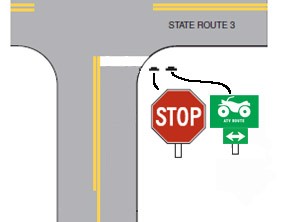
(2)
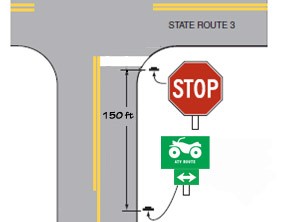
-
What is the offset from the edge of pavement that an ATV route sign should be placed?
- See question 9.
-
What height should an ATV route sign be placed?
- See question 9.
-
What height should a ATV route sign with an arrow assembly be placed?
- For questions 7-9, see the diagrams in Figure 2A-2 below (amended from the Federal MUTCD).
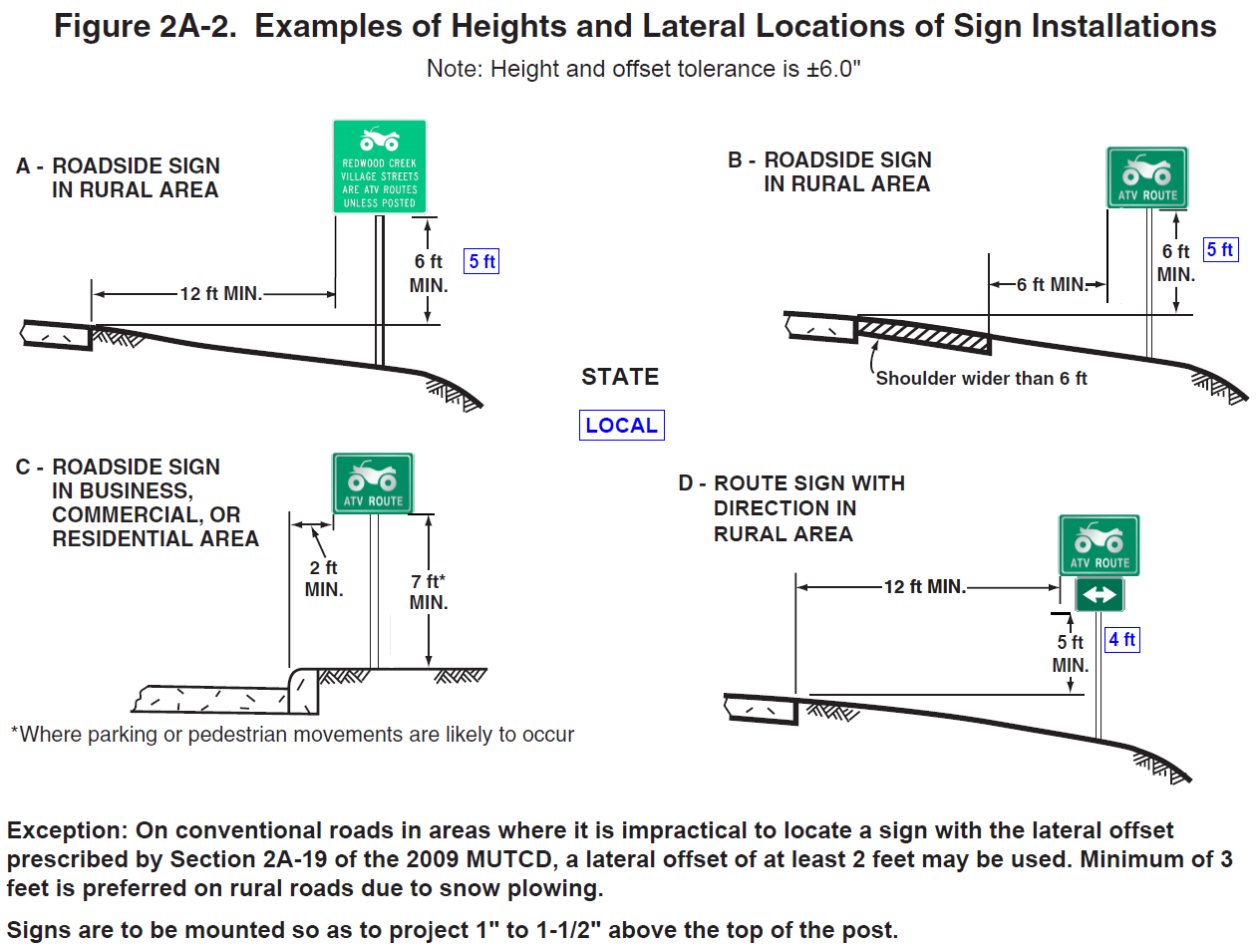
In the picture below, the ATV route sign is placed too low and may pose a hazard if struck by an errant vehicle or motorcycle. The sign must also be placed on its own post.
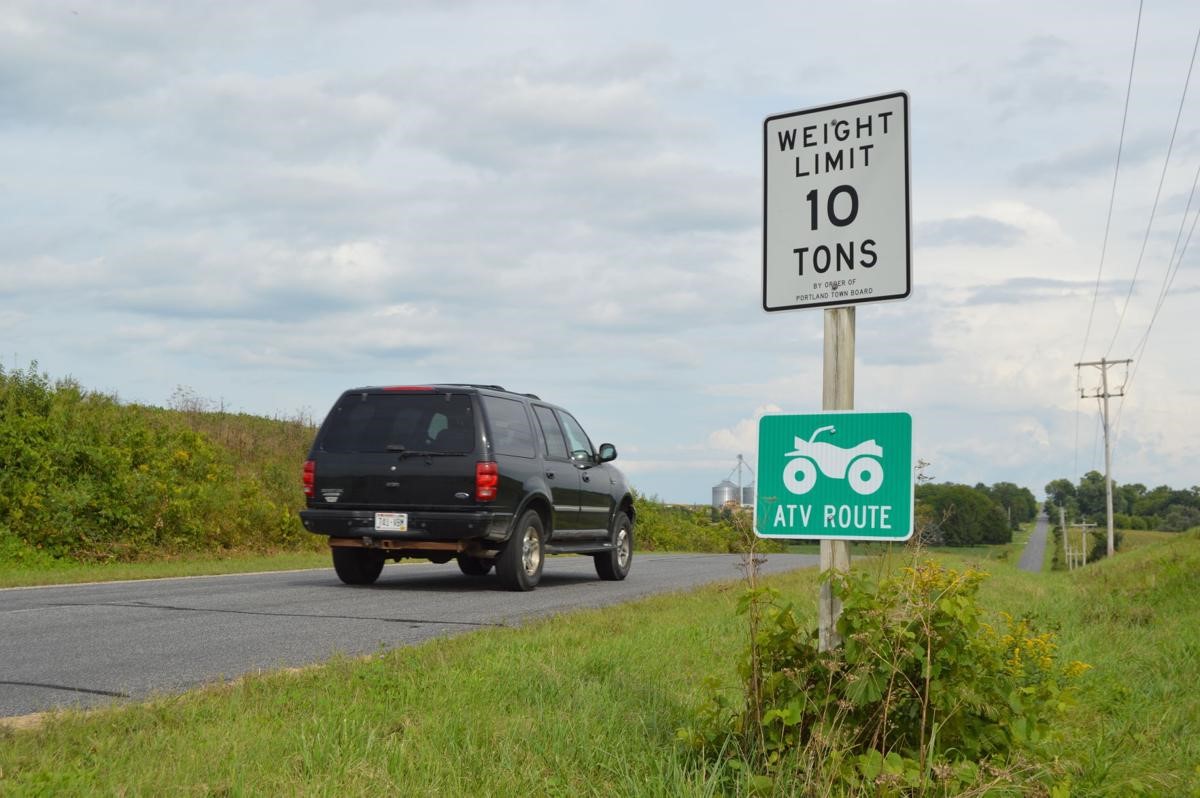
-
May the ATV symbol be used on an ATV speed limit sign?
- See question 11.
-
May an ATV speed limit sign have green letters on a white background?
- No for questions 10 and 11. The ATV symbol is only recognized in the WMUTCD for guide signs (white lettering on a green background). A speed limit sign is a regulatory sign. It must have black lettering on a white background. The correct design for an ATV limit sign is (4) above.
-
Where does the D11-10A sign need to be placed, i.e., at a municipal or county border, or at the beginning of the ATV route?
- Near the border. Under Wis. Stat.
s. 23.33(8)(e)3., “[a] town, village, city, or county may erect a sign on each highway that crosses its territorial boundary in a position to be viewed by motorists
as they enter the town, village, city, or county.”
-
May a town, village or city install ATV route signs on a county road?
- Maybe. The maintaining authority of the highway decides who erects ATV route signs on its roads.
-
Do I need a permit to put up ATV route signs?
- On state highways, yes. The WisDOT region office will issue the permit. On municipal and county highways, contact the maintaining authority of the highway.
-
 If a route on a local road continues straight at an intersection with a state highway, can you just erect the up arrow, or do you need an ATV route sign and the arrow?
If a route on a local road continues straight at an intersection with a state highway, can you just erect the up arrow, or do you need an ATV route sign and the arrow? - While an ATV route sign in addition to the up arrow is preferred, on local highways the up arrow by itself would be adequate. On a state highway, the arrow cannot be by itself.
-
Do you have examples of ATV route signing diagrams?
- Yes. Select any of the examples below.
Example 1 - Bridge crossing
Example 2 - 35 mph speed limit or less and D11-10A signing
Example 3 - Bridge crossing, 35 mph speed limit or less, and D11-10A signing
Example 4 - Close-up of Example 3
-
 When should the PREFERRED sign be used with an ATV route sign?
When should the PREFERRED sign be used with an ATV route sign? - Wis. Stat.
s. 23.33(8)(e)5. allows a municipality or county to designate a preferred route and erect signs marking the route over highways under their jurisdiction that have been designated as ATV routes.
-
Are U-channel posts okay to use to mount ATV route signs?
- Yes, if installed in accordance with the MUTCD. The WMUTCD did not change the language from the Federal MUTCD. From Section 2A.19, Paragraph 2: "Post-mounted sign and object marker supports shall be crashworthy (breakaway, yielding, or shielded with a longitudinal barrier or crash cushion) if within the clear zone."
Section 1A.13 of the MUTCD defines crashworthy: "Crashworthy—a characteristic of a roadside appurtenance that has been successfully crash tested in accordance with a national standard such as the National Cooperative Highway Research Program Report 350, “Recommended Procedures for the Safety Performance Evaluation of Highway Features.”
FHWA has issued eligibility letters for sign supports that have passed National Cooperative Highway Research Program Report 350 (NCHRP 350). These letters may be found at this
link.
On January 1, 2020, NCHRP 350 was superseded by the Manual for Assessing Roadside Hardware (MASH). FHWA is issuing eligibility letters for sign supports that pass MASH. These letters may be found at this
link. There are only two letters currently published there. WisDOT's understanding is that both perforated square steel tube post and U-channel posts have passed MASH, and that FHWA just needs to get the letters written and published.
-
Our municipality has developed an ATV ordinance that prohibits ATV operation during the hours of 12AM to 7AM, and proposes ATV speed limits on highways. Understanding the route signing requirements under Wis. Stat. s. 23.33, may signs be erected that would also include these hour restrictions and speed limits as part of the signs?
- No. A municipality or county has the authority to impose hours of operation and speed restrictions in their ordinance. However, those restriction messages, if used, should be posted on supplemental signs using the correct regulatory color scheme - black letters on a white background. They cannot be included on a D11-10 (left) or D11-10A sign (center). Generally, guide signs and regulatory signs should be on separate posts. In this case, it may be better to place the hours’ restrictions underneath the D11-10 sign as a plaque, but still black-on-white so it is regulatory like the example (right). The ATV speed limit sign shown in question 11 #(4) may be on a separate post to the right of these signs.

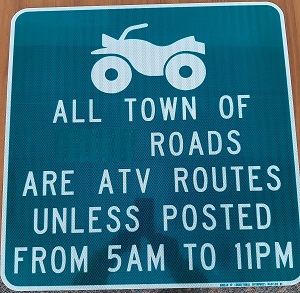
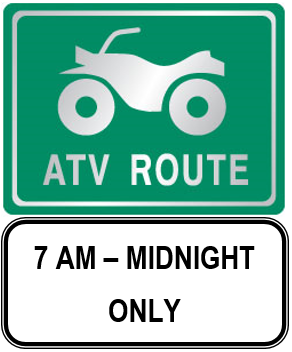
-
Our municipality has an ordinance that designated all of our highways as ATV and snowmobile routes. Can the D11-10A sign be modified to include this message as shown in picture (1)?
- No. That particular sign is not allowed in the WMUTCD. However, a white sign with black letters (regulatory sign) could be made without the symbols as shown in picture (2).
(1)
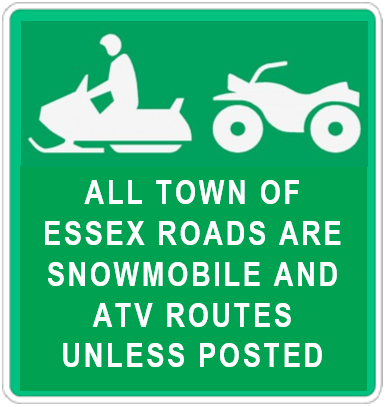
(2)
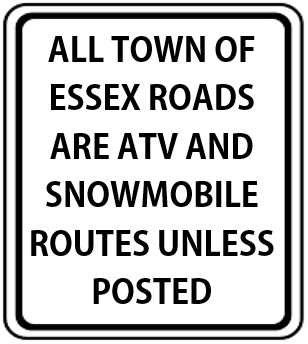
-
We have several roads with double STOP signs, e.g., signs on both sides of the road as shown in picture (1). Is it okay to place ATV route signs as shown in pictures (2) and (3) below?
- Yes to both situations. This is similar to question 5 only the ATV sign is facing the opposite direction.
-
Where should the ATV Route "END" sign be placed?
- On top as in picture (2) and not in combination as in picture (3). Also, the MK4-6 sign is "END" not "ENDS."
-
Our town has designated all of its roads as ATV routes and wants to use the D11-10A sign on all town roads. If we erect a D11-10A sign near the boundary, what signs would we need to install on the other side of the town road if the neighboring town does not allow ATVs on its roads?
- You would need to erect the MK4-6 sign and the D11-10 sign as shown in question 22, picture (2).
-
Are NO ATV TRAFFIC (R5-51) signs required on a highway that is not designated as an ATV route if it intersects a road that is designated as an ATV route?
- No. However, if ATVs are operating on the non-designated highway, NO ATV TRAFFIC signs should be erected. This is referenced in Wis. Stat.
s. 23.33(8)(e)4.
-
A county highway department is requiring the use of the NO ATV TRAFFIC sign in combination with placing a D11-10A sign on every county highway at the mutual county/town boundary since ATVs are not allowed on county roads. Is this permitted? Doesn't Wis. Stat. s. 23.33(8)(e)6. state that, "If a town, village, city, or county erects and maintains signs under subd. 3., the department
may not require the town, village, city, or county to erect any additional signs marking the all-terrain vehicle routes within the town, village, city, or county."
- Under s. 23.33(8)(e),
. was developed to allow a municipality or county to erect a sign on each highway that crosses its territorial boundary to alert motorists that all highways in the municipality or county have been designated as ATV routes. If D11-10 signs are erected, then a municipality or county does not have to erect signs on all ATV routes as required in
subd. 2. Subd. 6., however, does not refer to the R5-51, which is a regulatory sign prohibiting ATV operation. In addition, "the department" refers to the Department of Natural Resources, not a county highway department (CHD). Since the CHD has jurisdiction over the county highways it maintains, it may require R5-51 signs on those highways.
-
Are D11-10A signs mandatory on state and county trunk highways?
- No. Wis. Stat. s. 23.33(8)(e)3., states "may," which is not mandatory. If a municipality has designated all roads under its jurisdiction as ATV routes, the municipality has the option to erect D11-10A signs only on those municipal roads:
3. If a town, village, city, or county designates all highways under its jurisdiction as all-terrain vehicle routes under par. (b)2., the town, village, city, or county
may erect a sign on each highway that crosses its territorial boundary in a position to be viewed by motorists as they enter the town, village, city, or county. The signs shall alert motorists that all highways under the jurisdiction of the town, village, city, or county have been designated as all-terrain vehicle routes.
-
If a municipality uses D11-10A signs and it also "authorizes the operation" of ATVs on a STH where the posted speed limit is 35 MPH or less, are D11-10 signs also required?
- Yes. D11-10A signs may be used when a municipality designates all roads/streets under its jurisdiction (maintained by the municipality) as ATV routes under Wis. Stat. s. 23.33(8)(b)2. D11-10 signs are required to denote the 35 MPH (or less) zone limits for ATV operation on a STH under Wis. Stat. s. 23.33(11)(am)4. See this
diagram for two signing examples.
Contact WisDOT
▶ For
specific questions regarding your ATV situation, click on
transportation region office to see a state map with region boundaries and office contacts, telephone numbers and email addresses.
For general questions regarding WisDOT ATV policy or this website, contact:
Bob Fasick
Wisconsin DOT
Bureau of Highway Maintenance
4822 Madison Yards Way, 5th Floor South
Madison, WI 53705
(608) 266-3438
robert.fasick@dot.wi.gov
Stay safe on the road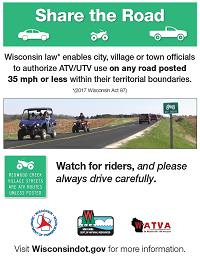
Whether driving a car or operating an ATV, it's important to always eliminate distractions, be patient and stay focused.
- Motorists who encounter ATVs on the road should slow down and wait for a safe opportunity to pass.
- ATV riders should always be aware of their surroundings, stick to authorized areas and always use helmets and protective gear.
The
Wisconsin DNR publishes additional resources on ATV safety and registration. Additionally, interested parties can help spread the word by displaying the
Share the Road flyer (pictured right).